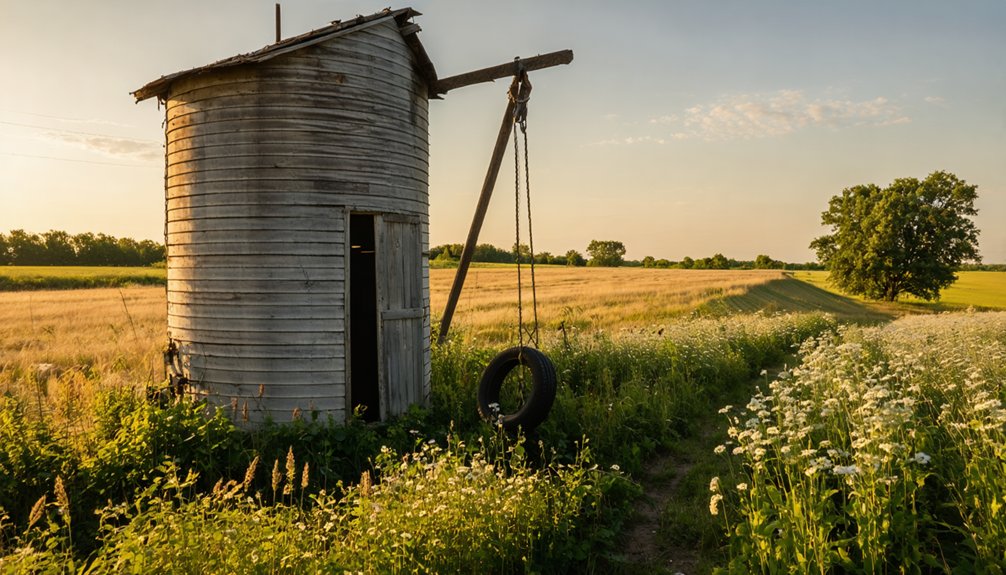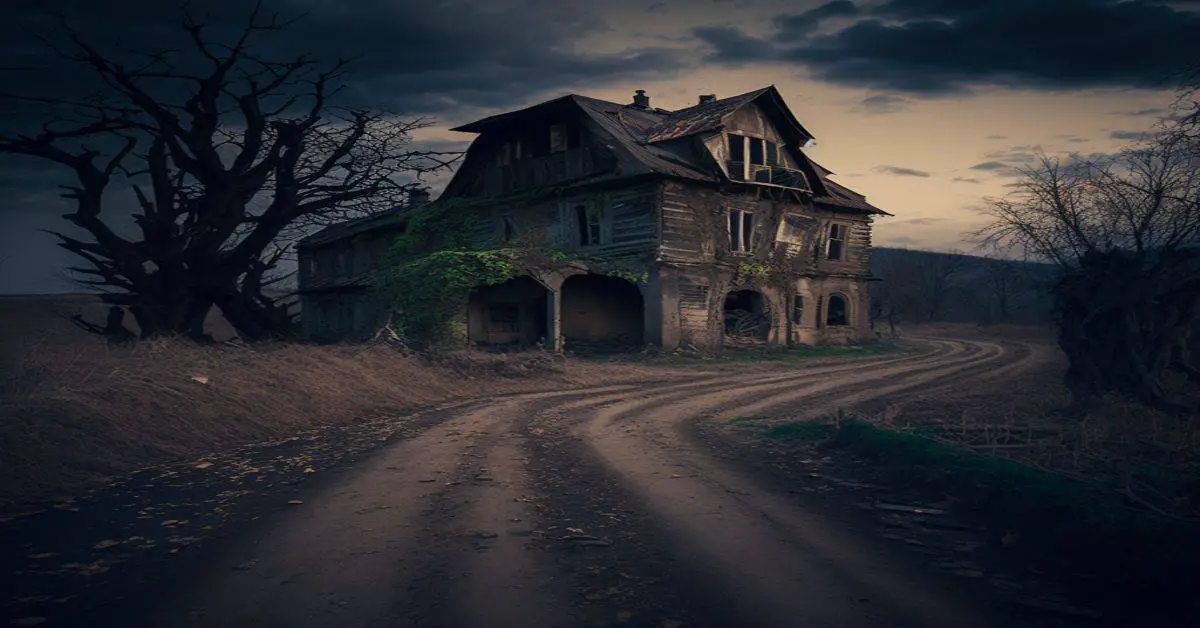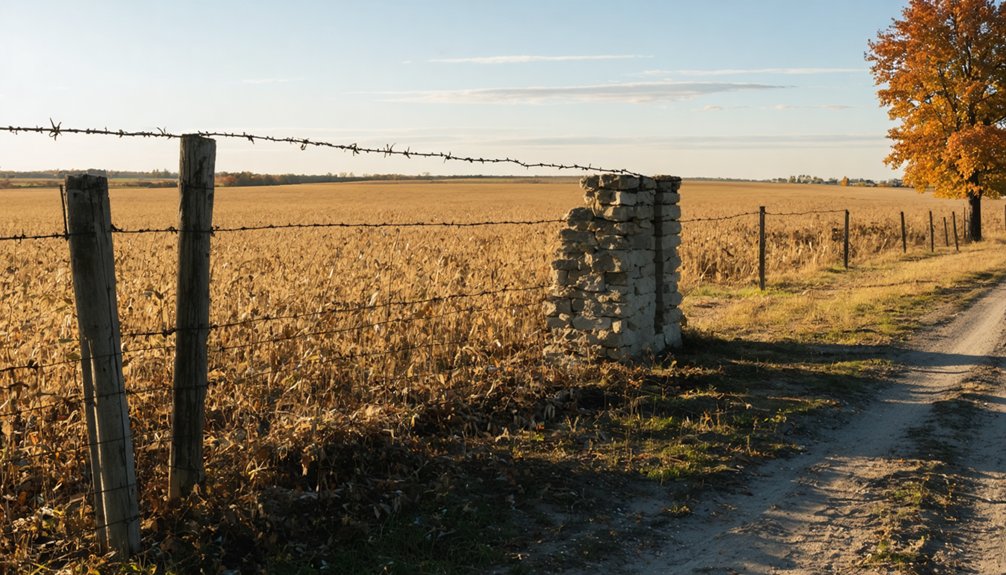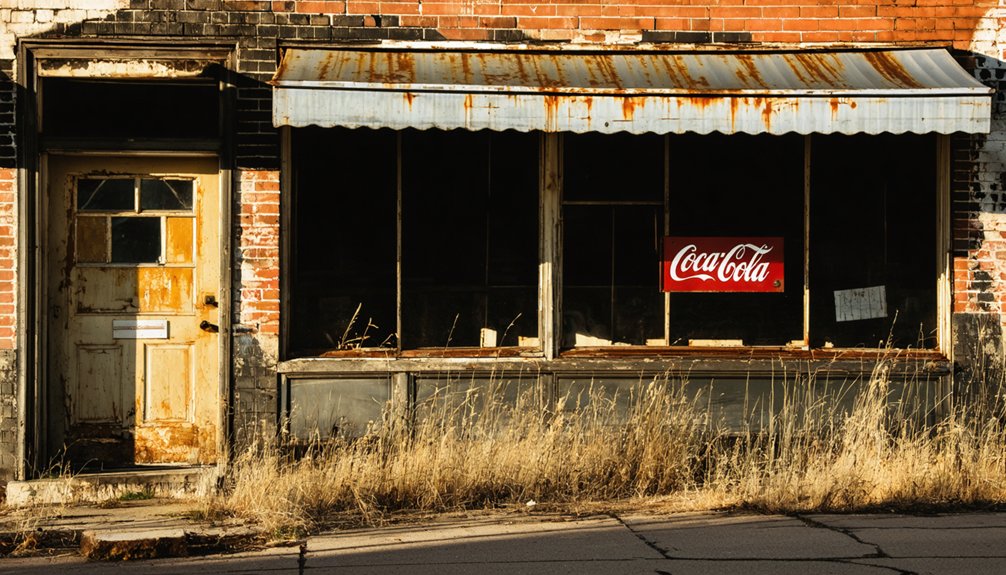You’ll find Schoper’s haunting remains in Illinois, where Standard Oil transformed a 500-acre farm into a bustling company town in 1918. Their $1 million investment built 192 Sears Honor-Bilt homes and established a thriving coal mining community that supported Midwest refineries. At its peak in the 1920s, over 1,000 miners worked the rich seven-foot coal seam, but economic shifts and dwindling oil production led to its abandonment. The empty streets now whisper stories of America’s industrial ambitions.
Key Takeaways
- Schoper began as a planned coal mining community in 1918, established by Standard Oil of Indiana on Thomas Schoper’s former farmland.
- Standard Oil invested $1 million to build 192 Sears Honor-Bilt homes, creating a company town for coal mining workers.
- The town reached its peak in the early 1920s with over 1,000 miners, becoming Illinois’ largest coal mining operation.
- Economic decline began when oil production fell, coupled with the loss of crucial railroad connections to refineries.
- Mass exodus occurred as families sought opportunities elsewhere, transforming Schoper into a ghost town without new industries or government support.
The Birth of an Oil Boom Town
While many Illinois towns grew organically over decades, Schoper emerged virtually overnight in 1918 when Standard Oil of Indiana transformed Thomas Schoper’s 500-acre farm into a planned coal mining community.
You’d have witnessed an unprecedented rush as the company invested $1 million to create an instant town, driven by wartime coal shortages near their Midwestern refineries.
After geological surveys revealed a rich seven-foot coal seam, Standard Oil wasted no time establishing modern mining techniques and efficient coal transportation systems.
They capitalized on the site’s proximity to the Chicago and Alton Railroad, which connected their Wood River and Whiting refineries.
Within months, the rural farmland transformed into a bustling industrial center complete with prefabricated housing, power facilities, and infrastructure designed to support hundreds of incoming workers. Standard Oil constructed twelve Honor-Bilt homes for their mine supervisors, establishing a proper company town.
While coal was the primary focus, the company also recognized the potential for oil production, as Illinois had already established itself as the No. 3 oil producer in the nation during its first oil boom from 1907-1912.
Standard Oil’s Million-Dollar Investment
Standard Oil’s ambitious $1 million housing project in 1918 transformed a quiet Macoupin County farm into a bustling company town, marking one of the largest single investments in prefabricated housing of the era.
You’d have witnessed a flurry of activity as 192 Sears Honor-Bilt homes were rapidly assembled near the coal fields, creating an instant community complete with modern amenities to house skilled workers.
The company’s strategic development of Schoper showcased Standard Oil’s determination to secure its energy supply chain through vertical integration, while simultaneously boosting the local economy through construction jobs and increased commerce. The project reflected Standard Oil’s core philosophy of economies of scale, as they applied their industrial efficiency model to community building.
Before this development, Standard Oil had already demonstrated its market dominance by controlling 88 percent of refined oil flows across America by 1890.
Massive Local Economic Impact
Following years of agricultural dominance in rural Illinois, the establishment of Schoper marked an unprecedented economic transformation when Standard Oil of Indiana invested $1 million in 1918 – equivalent to tens of millions today.
This massive community development project fundamentally altered the region’s economy, transforming farmland into an industrial powerhouse. The company’s emphasis on economic efficiency drove major operational improvements across the region. Standard Oil’s proven track record of maintaining quality and service in the petroleum industry made it a trusted name in the community.
- You’d have witnessed hundreds of workers and their families flooding into the area, creating instant demand for goods and services.
- You’d have seen local businesses spring up to support the burgeoning population, from general stores to entertainment venues.
- You’d have noticed the rapid development of infrastructure, including rail improvements and utility expansions.
The investment created ripple effects throughout the local economy, establishing Schoper as an essential industrial hub while providing stable, high-paying jobs in what was previously a farming region.
Building A Company Town
During the early months of 1918, a remarkable transformation began in Schoper when an unprecedented $1 million order arrived at Sears Roebuck headquarters – a purchase that would establish one of Illinois’ most ambitious company towns.
You’d have witnessed Standard Oil’s vision unfold as 192 Honor-Bilt homes sprouted from the prairie, transforming scattered farmland into a structured community.
These weren’t ordinary houses – they arrived by rail in pre-cut pieces, designed for quick assembly near the mines and refineries. The innovative flat-packed materials allowed even unskilled carpenters to construct these homes efficiently.
The company town dynamics centered on efficiency: workers lived within walking distance of their jobs, while managers occupied special houses on refinery property for round-the-clock operations.
Every aspect, from roads to utilities, was strategically planned to create a self-sufficient ecosystem where workers could thrive while serving Standard Oil’s industrial empire. The Schoper Mine became a cornerstone of local employment, with 650 miners working to extract thousands of tons of coal daily.
Strategic Oil Field Development
When a devastating coal shortage gripped America in 1917, the executives at Standard Oil recognized an opportunity in Thomas Schoper’s farmland, where geological surveys had revealed a promising seven-foot coal seam.
You’ll find that Standard Oil’s strategic resource management went far beyond simply buying the 500-acre property – they invested $1 million to transform it into a self-sustaining operation.
- Direct rail access to refineries in Wood River and Whiting via the Chicago & Alton Railroad
- Complete vertical integration controlling extraction, transport, and refining
- Modern industrial-grade mining facilities designed for 24/7 operations
The company’s commitment to economic sustainability showed in every detail, from the efficient town layout to the power plant and maintenance facilities. The Devonian oil production discoveries in nearby Sandoval field further validated their investment in the region. The site later became crucial for enhanced oil recovery, as waterflooding techniques were implemented to maximize resource extraction from mature oilfields.
They’d created a complete supply chain that would feed their Midwest refineries and reduce dependence on external suppliers during market volatility.
Life in a Company Town
In the bustling oil town of Schoper during the early 1920s, you’d find your daily routine strictly governed by Standard Oil’s whistles, which signaled shift changes and meal breaks throughout the company’s 24-hour operations.
Your family would likely occupy one of the identical wood-frame houses built in neat rows along the town’s gridded streets, with monthly rent and utilities automatically deducted from your paycheck.
On weekends, you’d join your fellow workers and their families at company-sponsored events, from summer picnics to holiday celebrations, all carefully organized to foster a sense of community while maintaining the company’s influence over social life.
Daily Worker Routines
Life for Schoper’s workers revolved around Standard Oil‘s demanding coal mining operations, where shifts ran day and night to maximize production.
You’d face daily challenges walking to the mines or catching company transport, always under the watchful eye of management. Your worker struggles included harsh labor conditions and limited personal freedoms, with every aspect of life tied to the company’s strict control.
- You’d spend long hours underground mining coal or maintaining equipment, with minimal breaks.
- You couldn’t shop anywhere except company stores, where your wages quickly disappeared.
- Your social activities were limited to company-approved events and church gatherings.
Even your travel beyond town required company oversight, ensuring you remained tethered to Schoper’s industrial machine.
The routine was relentless, designed to serve Standard Oil’s interests above all else.
Company Housing Benefits
The coal miners’ demanding work schedule came with one significant upside: Standard Oil provided housing for its employees in Schoper. Among the company benefits, you’d find yourself living in one of the simple yet functional homes built specifically for workers and their families.
You didn’t have to worry about finding accommodation or negotiating with landlords – housing was part of your employment package.
The housing advantages meant you’d live close to your workplace, eliminating long commutes in harsh weather conditions. Your neighbors were fellow miners, creating a tight-knit community where everyone understood the challenges of mining life.
While Standard Oil maintained ownership of these homes, you enjoyed basic maintenance services and reasonable rents deducted directly from your wages, providing stability for your family.
Social Activities Calendar
Social activities in Schoper revolved around three seasonal community gatherings that brought miners’ families together throughout the year.
You’d find these events anchored in the town’s mining schedule, with celebrations timed around major work milestones. The coal company supported these gatherings to boost worker morale and strengthen community bonds.
- Summer Picnics: Held in July when mining operations slowed, featuring baseball games, potluck dinners, and outdoor music
- Harvest Festival: A fall celebration where families shared home-grown produce, crafts, and mining achievement awards
- Winter Social: Typically held in the company hall, combining holiday festivities with recognition of veteran miners
These family events helped offset the town’s limited entertainment options and created lasting connections between mining households, fostering a spirit of mutual support during both prosperous and lean times.
Peak Years and Population Growth
During its heyday in the early 1920s, Schoper emerged as a bustling coal mining hub, anchored by what was then Illinois’ largest coal mine employing 650 men alongside the neighboring Berry Mine’s 450-strong workforce.
Schoper’s dominance in Illinois coal mining peaked in the 1920s, with over 1,000 miners powering the region’s industrial growth.
The population dynamics reflected this industrial boom, with miners working an impressive 298 days annually – far exceeding the national average of 200 days.
The mining impact transformed the landscape as Standard Oil invested heavily in worker housing, including 12 distinctive Sears Honor-Bilt homes for supervisors.
You’ll find the town’s rapid growth mirrored the region’s broader coal industry expansion, with daily coal production reaching 4,000 tons at Schoper mine and 2,000 tons at Berry Mine.
While exact population figures aren’t recorded, the workforce size suggests several hundred residents plus their families called Schoper home.
The Sudden Decline
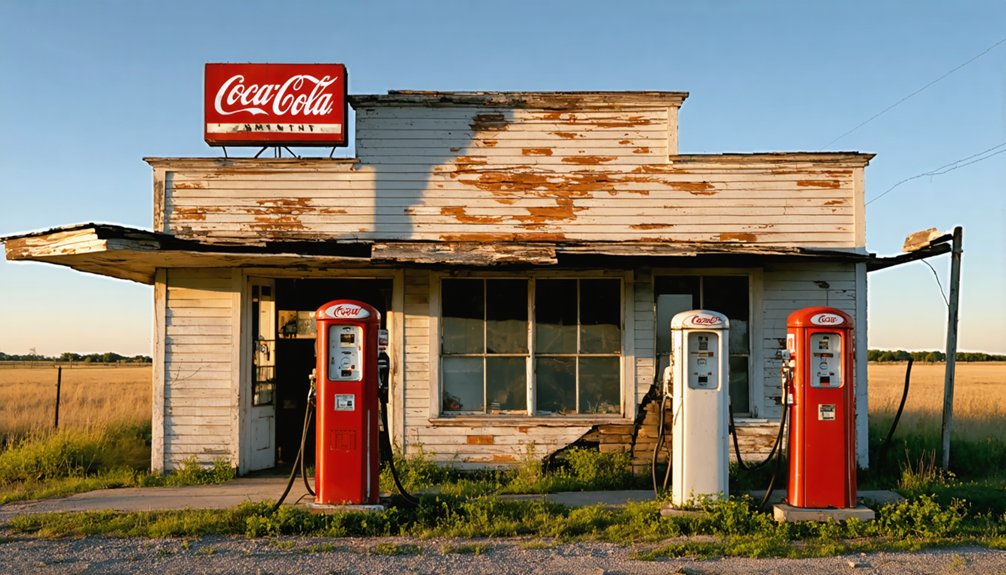
While Standard Oil’s initial $1 million investment sparked Schoper’s meteoric rise in 1918, the town’s fortunes reversed dramatically as oil production plummeted in the following decades.
The combination of economic factors, including the loss of railroad connections and lack of industry diversification, dealt crushing blows to the community’s survival.
You’ll find that demographic shifts occurred rapidly as families sought opportunities elsewhere, leaving behind empty storefronts and declining services.
- The town’s isolation deepened when railroad routes changed, cutting off essential trade networks
- Younger residents abandoned Schoper for urban areas, accelerating the population decline
- Without government intervention or new industries, the exodus continued unchecked
What Remains Today
Today, virtually nothing remains of the once-bustling Schoper settlement except scattered concrete foundations and overgrown pathways where streets once lay.
Nature has reclaimed most of the 500-acre expanse where Thomas Schoper’s farm once stood. You’ll find no trace of the massive Federalist-style powerhouse and mine offices that once dominated the landscape.
The ghost town’s last notable remnants today were two Sears Houses that had been relocated just outside Standard City, with one serving as the final residence of John McMillan and his wife.
Legacy of a Lost Community
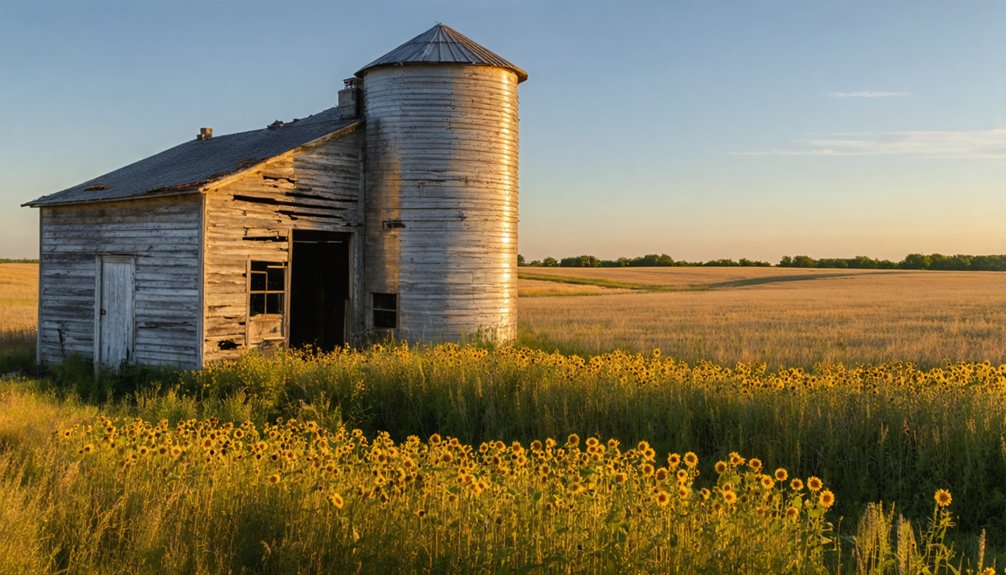
Beyond the physical remnants, Schoper’s lasting impact can be traced through the economic and social patterns that shaped central Illinois in the early 20th century.
You’ll find that Schoper’s historical significance lies in its representation of the boom-and-bust cycle that defined many industrial towns of its era. The town’s community identity, though brief, exemplifies the resilient spirit of early 20th-century industrial workers who built lives around emerging opportunities.
- The town’s transformation from farmland to industrial center demonstrates the rapid pace of American industrial development.
- Schoper’s story serves as a cautionary tale about the risks of single-industry dependence.
- The dispersal of Schoper’s residents into surrounding communities contributed to the region’s evolving social fabric.
Frequently Asked Questions
Were There Any Major Accidents or Disasters in Schoper’s Oil Fields?
You won’t find oil field accidents in Schoper because it wasn’t an oil town at all. The area’s risks centered around coal mining operations, though no major disasters are documented.
What Happened to the Families Who Lived There After the Town Died?
You’ll find most families chose relocation to nearby towns like Carlinville, seeking new jobs and opportunities. While their community legacy lives on through descendants, they scattered throughout Illinois’s heartland.
Did Any Other Industries Attempt to Establish Themselves in Schoper?
Like a withered field awaiting new seeds, Schoper saw brief mining attempts and agricultural ventures after Standard Oil left, but none took root. You won’t find records of other industries succeeding there.
What Was the Highest Recorded Oil Production in Schoper’s Peak Years?
You won’t find any recorded oil production peaks for Schoper, as there wasn’t an oil boom there. Despite Standard Oil’s ownership, the town focused exclusively on coal mining operations.
Were There Any Schools or Churches Built During the Town’s Existence?
You won’t find records of schools or churches built in Schoper. Residents likely traveled to nearby Carlinville for their educational and religious needs, following typical rural Illinois patterns of the era.
References
- https://www.youtube.com/watch?v=93k0qtvzkn4&vl=en-US
- https://www.youtube.com/watch?v=gM3ZIgtFzBk
- https://searshomes.org/index.php/2013/12/31/new-information-on-schoper-illinois/
- https://www.freakyfoottours.com/us/illinois/
- https://michaelkleen.com/2021/11/23/coles-county-ghost-towns-hitesville-farmington-and-curtisville/
- https://drloihjournal.blogspot.com/p/lost-towns-of-illinois-series.html
- https://searshomes.org/index.php/2011/05/23/carlinville-and-schoper-illinois/
- https://storymaps.arcgis.com/stories/043201d4267e4a66b44e7922832df7a2
- https://en.wikipedia.org/wiki/List_of_ghost_towns_in_Illinois
- https://illinoispetroleumresourcesboard.org/industry/
